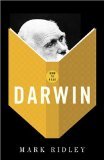 How to Read Darwin (How to Read)
How to Read Darwin (How to Read)
by Mark Ridley
Granta Books, £6.99 ISBN 1-86207-728-2
How to Read Darwin is one of a new series of slim guides from Granta, the first batch of which also deals with figures as diverse as Freud, Hitler, Nietzsche, de Sade and Wittgenstein. The intention appears to be to emulate the success of series such as Fontana’s Modern Masters and Oxford’s Past Masters, both of which published volumes on Darwin in 1982, the centenary year of his death. “How to Read”, though, claims to take an original approach, skipping biography and cutting to the ideas. Thus, apart from a brief chronology, we hear little about Darwin’s personal life. What we do get is a distillation of the ideas, liberally quoted, with a commentary. Six chapters cover “The Origin of Species” (as it is called throughout), three The Descent of Man and the final one The Expression of the Emotions in Man and Animals.
As to originality of approach, it is hardly novel to quote quantities of a writer’s own words, though it is novel to dispense with the potted biography. But the attempt to do justice to the complexities of Darwin’s thought is undermined by the marketing decision to limit the number of pages. The extracts, while interesting, seem arbitrary. This might not be an issue with a writer like Wittgenstein, who published relatively little, but we are not told why the selections here are deemed representative of the enormous quantity that Darwin wrote, and his range is barely hinted at.
Where the book does score highly is in setting Darwin’s mid-Victorian ideas in the context of modern discoveries, particularly in genetics, showing what is still of value and what has been superseded. In this regard the book, despite its ridiculous cover, will make a useful contribution to the literature for the busy student. However, one is still left uneasy in these post-modern times by the dogmatic “How to Read”. Perhaps “Ways to Read” would be more appropriate. late the success of series such as Fontana’s Modern Masters and Oxford’s Past Masters, both of which published volumes on Darwin in 1982, the centenary year of his death.
“How to Read”, though, claims to take an original approach, skipping biography and cutting to the ideas. Thus, apart from a brief chronology, we hear little about Darwin’s personal life. What we do get is a distillation of the ideas, liberally quoted, with a commentary. Six chapters cover “The Origin of Species” (as it is called throughout), three The Descent of Man and the final one The Expression of the Emotions in Man and Animals. As to originality of approach, it is hardly novel to quote quantities of a writer’s own words, though it is novel to dispense with the potted biography. But the attempt to do justice to the complexities of Darwin’s thought is undermined by the marketing decision to limit the number of pages. The extracts, while interesting, seem arbitrary. This might not be an issue with a writer like Wittgenstein, who published relatively little, but we are not told why the selections here are deemed representative of the enormous quantity that Darwin wrote, and his range is barely hinted at.
Where the book does score highly is in setting Darwin’s mid-Victorian ideas in the context of modern discoveries, particularly in genetics, showing what is still of value and what has been superseded. In this regard the book, despite its ridiculous cover, will make a useful contribution to the literature for the busy student.
However, one is still left uneasy in these post-modern times by the dogmatic “How to Read”. Perhaps “Ways to Read” would be more appropriate.
Tom Ruffles

